A Guide to Chatbot Customer Experience: Benefits, Features & Examples

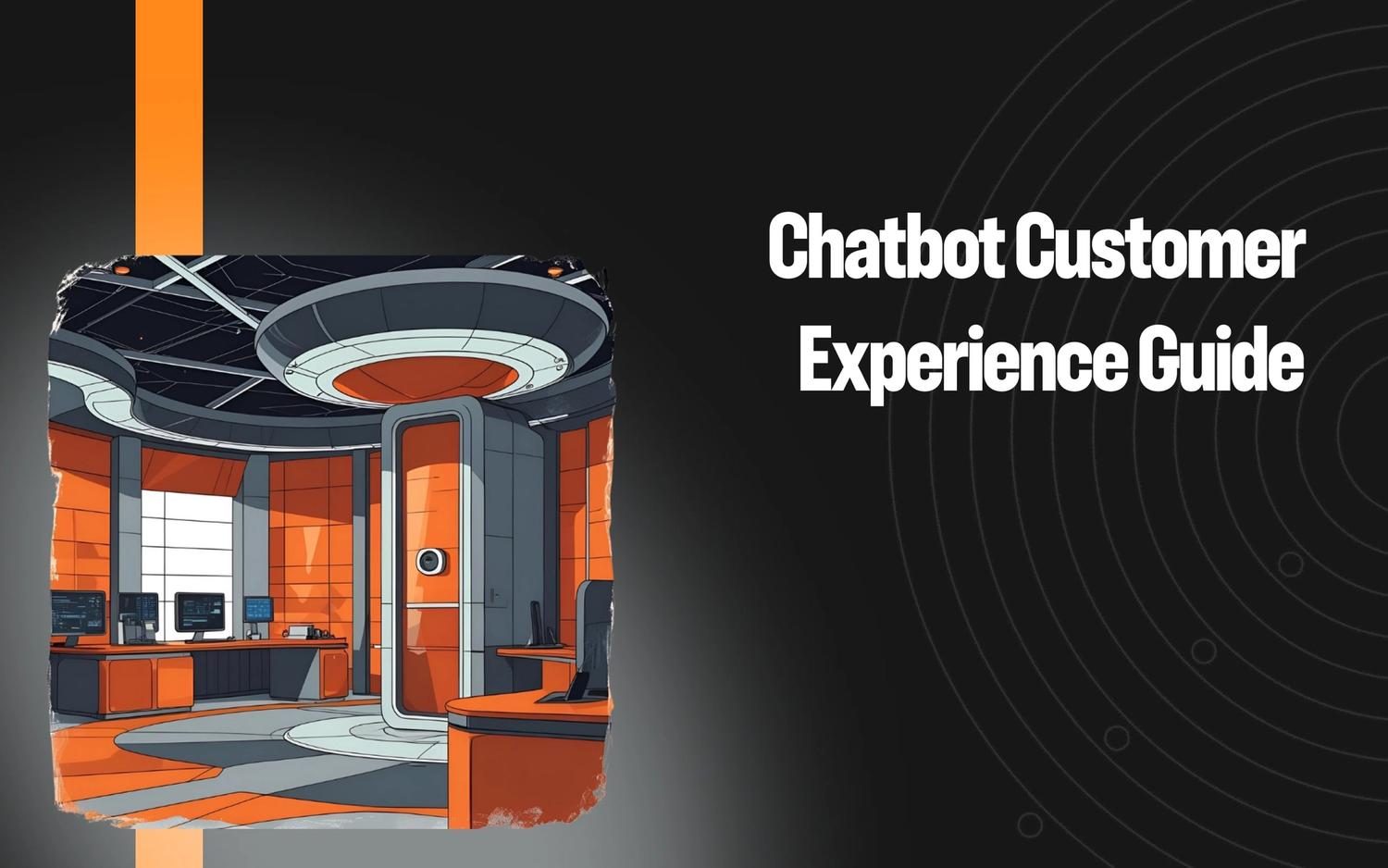
Key Takeaways
- AI chatbots provide 24/7 support, reduce wait times, and improve customer satisfaction.
- They also free up agents to focus on complex, high-value interactions.
- Intelligent bots can manage seamless handoffs to humans when required.
- They also handle tasks autonomously, pulling real-time data for accurate responses.
- Chatbots continuously learn from interactions, turning every conversation into customer experience insights.
Nowadays, chatbots are often the first (and only) point of contact between customers and brands, and that interaction increasingly shapes how people feel about the entire company. They want more than a quick answer; they expect clear communication, real support 24/7, and a sense they’re being heard, even when no human is involved.
This means CX teams must treat chatbots as core experience channels. Businesses that approach chatbot design with the same care as human service channels will stand out.
Intelligent, well-implemented chatbots maintain customer satisfaction and loyalty. Teams that know how to balance automation with human involvement — for instance, by routing complex or sensitive queries to live agents when needed — will deliver a customer experience that feels both efficient and genuinely supportive.
But meeting those expectations isn’t easy. Some chatbots still disappoint in ways that feel all too familiar, like offering canned or irrelevant replies, not properly grasping intent, struggling with emotional nuance, or making it difficult to escalate when human contact is needed.
New advances in AI and natural language processing are enabling chatbots to overcome such challenges gradually, however. Some of today’s bots can better understand context, pick up on what a customer really means, and even detect emotional signals.
Below, we explain how chatbots work in the context of customer experience and lay out seven ways a support team can use them. We also give examples using our AI Virtual Agent, which is built on Level AI's conversational intelligence and QA automation platform, and which converses naturally while autonomously handling tasks.
What We’re Covering
- How Chatbots Work (and How AI Makes Them Better)
- 7 Ways Chatbots Deliver Better Customer Experience
- 24/7 Availability That Eliminates Wait Times
- They Give Agents More Time to Handle Complex, High-Value Conversations
- Intelligent Handoffs and Escalations That Keep Service Flowing
- Autonomous Task Handling for Faster Resolutions
- Consistent, Human-Like Experiences in Voice and Chat
- Turning Every Conversation Into Customer Insights
- Lower Support Costs Without Sacrificing Quality
How Chatbots Work (And How AI Makes Them Better)
Chatbots are contact center automation tools that rely on NLP to help them grasp the intent and subtleties of human language. This, in turn, lets them respond in ways that are aligned with what the customer is trying to say. When done successfully, this reduces friction, increases customer engagement and retention, and makes conversations feel in tune with the customer’s situation.
Many chatbots use frameworks like decision trees to respond to customers, and draw answers from a single source of truth like a knowledge base, FAQ, or company website. The accuracy and freshness of this information are highly important; customers expect up-to-date answers when resolving issues or making decisions, and outdated or incorrect content erodes trust. By using centralized, current information, chatbots can provide consistent and accurate answers no matter the channel.
Another key element of their design is escalation. Many are programmed with clear points for handoff to human agents, especially when a customer asks to speak to someone directly or when the issue is beyond the chatbot’s ability to resolve. This recognition of their own limits helps prevent dead ends or repetitive loops (along with user frustration).
That said, there’s a big difference between traditional chatbots and those powered by artificial intelligence. Legacy chatbots work through fixed workflows based on structured rules and keyword matching. They “listen” for certain words or phrases, then match them to preset rules or scripts to decide what to do next.
While this works for simple, predictable questions, it often breaks down when customers phrase things differently, ask multiple questions at once, or move the conversation in unexpected directions.
Legacy chatbots also have limited contextual understanding. They struggle with interruptions, topic shifts, and the back-and-forth flow of real conversations. Some can detect basic sentiment (whether a message sounds positive or negative), but this detection sometimes fails to translate into meaningful responses. Because bots miss subtle emotional cues like disappointment versus disapproval, customers often leave feeling misunderstood or ignored.
AI-driven chatbots, by contrast, are designed to handle the complexity of real human dialogue. They combine LLMs with business logic to create conversations that are natural, fluid, and human-like. These bots can generate contextually relevant responses in real time, adjusting tone and level of detail to fit the situation. This makes interactions feel less scripted and more natural.
One of their key strengths is emotional intelligence. AI-enabled chatbots can detect sentiment with much more nuance, allowing them to show empathy, shift tone, or escalate to a human agent when needed. This improves the emotional quality of the interaction and helps customers feel understood, reducing frustration and building greater trust in the brand.
Advanced chatbots offer functionality for integrating with business systems like CRMs to personalize responses, recommendations, or offers. They can also take autonomous actions like updating account information, reducing resolution time, and removing the need for repetitive explanations.
More importantly, they learn and improve over time. By tracking user responses, analyzing customer data, and adapting their models, they become more accurate and effective with each interaction. Customer feedback loops help them identify gaps, expand knowledge, and continuously refine performance.
In short, while traditional chatbots are based on static decision trees, AI-driven chatbots are spontaneous and emotionally intelligent. They don’t just automate conversations; they humanize them, offering customers a more personalized, productive, and human-like experience.
7 Ways Chatbots Deliver Better Customer Experience
1. 24/7 Availability That Eliminates Wait Times
Customers expect answers at all times of the day, and chatbots are uniquely positioned to meet this demand — regardless of time zone or traditional business hours. This constant availability ensures that questions are handled promptly and minimizes frustration.
Chatbots are good at handling high volumes of repetitive tasks or recurring questions. By automating common inquiries, they deliver instant responses and eliminate wait times for customers who are simply looking for quick information. The result is faster resolutions and greater convenience, both of which directly optimize customer satisfaction.
More advanced AI-powered chatbots take this experience a step further by detecting sentiment, understanding context, and responding in ways that feel more natural. They adapt their tone in real time and carry on conversations efficiently and with empathy. This ability to combine speed with emotional awareness helps customers feel heard and supported rather than rushed through an interaction.
Ultimately, chatbots provide the functionality and convenience to meet customer expectations, while advanced AI agents improve the experience with empathy and personalization.
2. They Give Agents More Time to Handle Complex, High-Value Conversations
Chatbots cut down on the number of tickets that reach human agents by handling simple, routine customer inquiries. This helps prevent long wait times for customers and gives agents more time to focus on issues that actually require human judgment, like complex, sensitive, or high-stakes conversations.
When agents aren’t bogged down with repetitive tasks, they can devote more attention to each challenging case, resulting in thoughtful and empathetic resolutions. That extra care strengthens customer trust and improves overall satisfaction.
Advanced chatbots take this even further by learning which questions come up most often. For example, Level AI’s Virtual Agent reviews thousands of past conversations to identify high-volume, repeatable requests during the setup process.
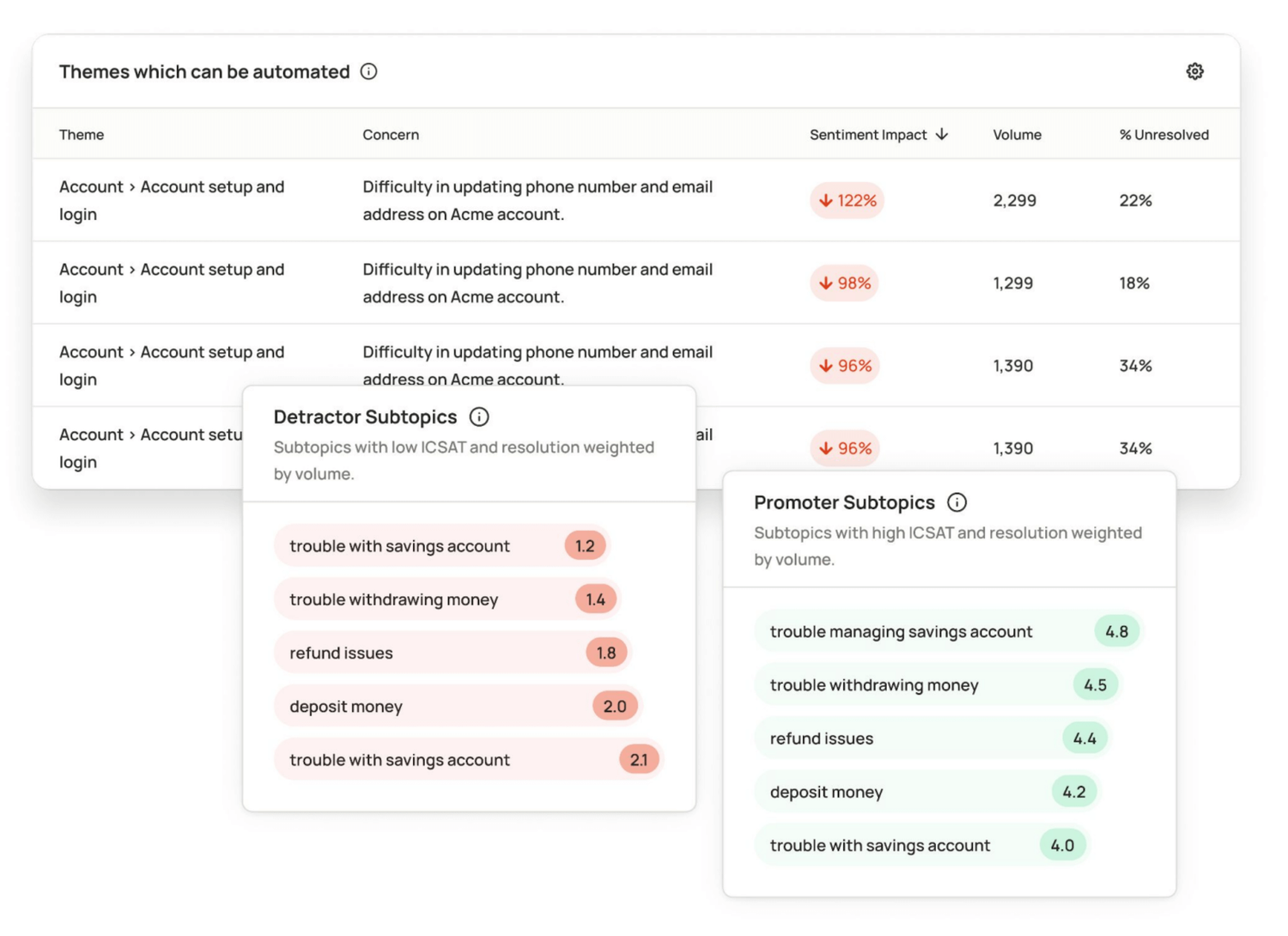
The setup is automated and simple, and can be completed in just a few days without engineering resources.
Once the Virtual Agent is in place, it handles common informational and transactional queries on its own. The result is a balanced approach: customers get quick, accurate responses to routine questions, while still having access to skilled, caring human agents for more complex issues.
3. Intelligent Handoffs and Escalations That Keep Service Flowing
While chatbots excel at handling high-volume, repetitive tasks and providing instant answers to FAQs, they aren’t suitable for all types of customer inquiries. A well-designed chatbot has limits and clear rules for when to bring in a human. For example, if the bot can’t solve a problem after several back-and-forth exchanges, or if the customer shows signs of frustration, it should immediately offer to connect the person with a live agent or arrange a callback.
This matters because certain issues, like complicated tech problems, sensitive customer concerns, or emotionally charged complaints, need the empathy, flexibility, and problem-solving skills that only a human can provide.
Intelligent chatbots are built to recognize these situations. They use tools like sentiment and intent detection to decide when an escalation is the best option. For instance, if a customer sends a message revealing frustration, the bot can quickly pass the conversation to a human agent to defuse the situation.
During the handoff, artificial intelligence can pass these collected details and context (which includes previous purchases, customer interactions, or support tickets) to the human agent. This allows the agent to jump into the conversation already informed, reducing the time spent catching up.
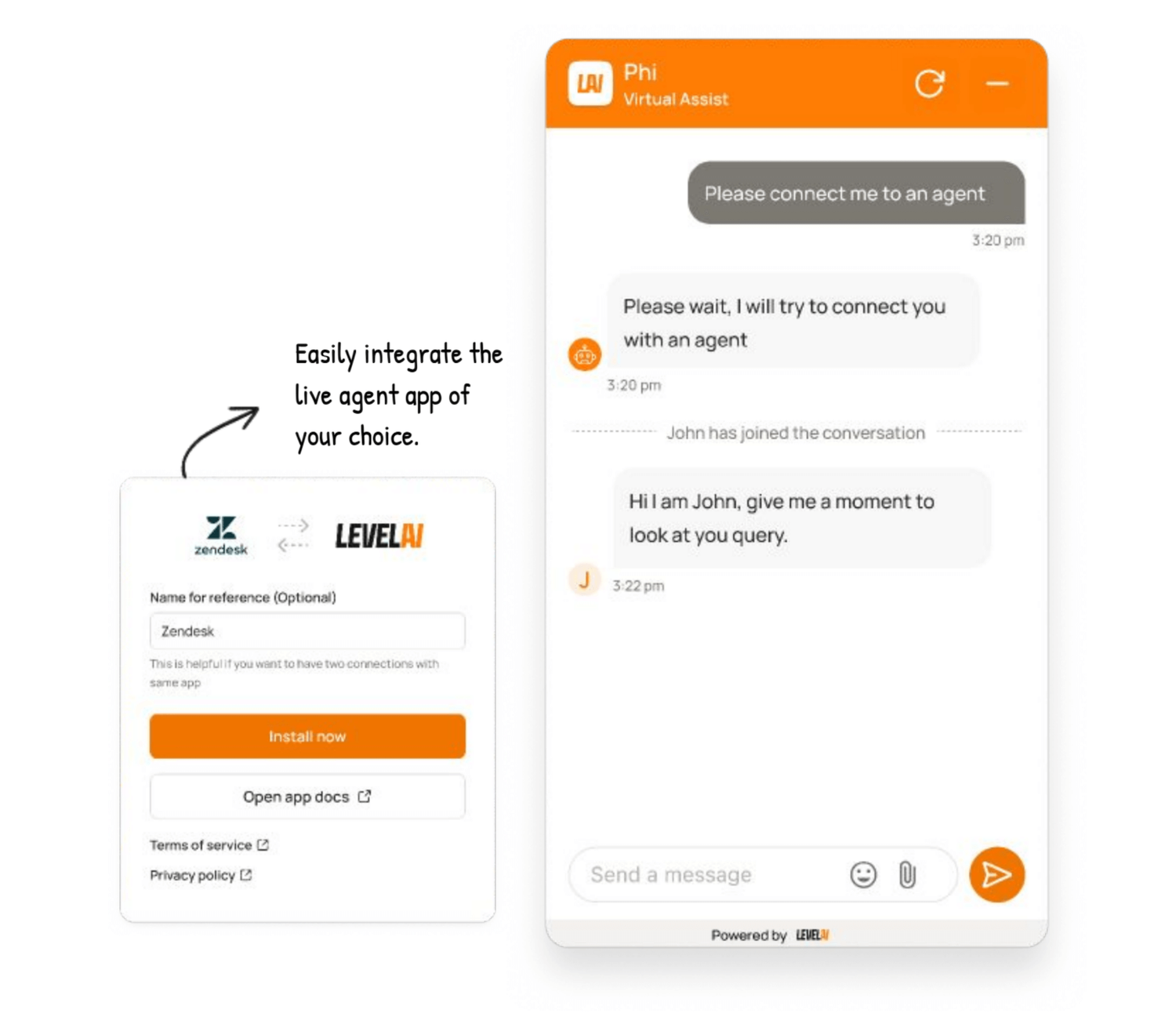
Our AI Virtual Agent takes this one step further. By combining intent and sentiment detection, it interprets not only the meanings of words but also the underlying emotion, which is based on the platform’s natural language understanding and semantic intelligence. Our customer sentiment analysis detects up to eight different emotions, from anger and worry to happiness and admiration.
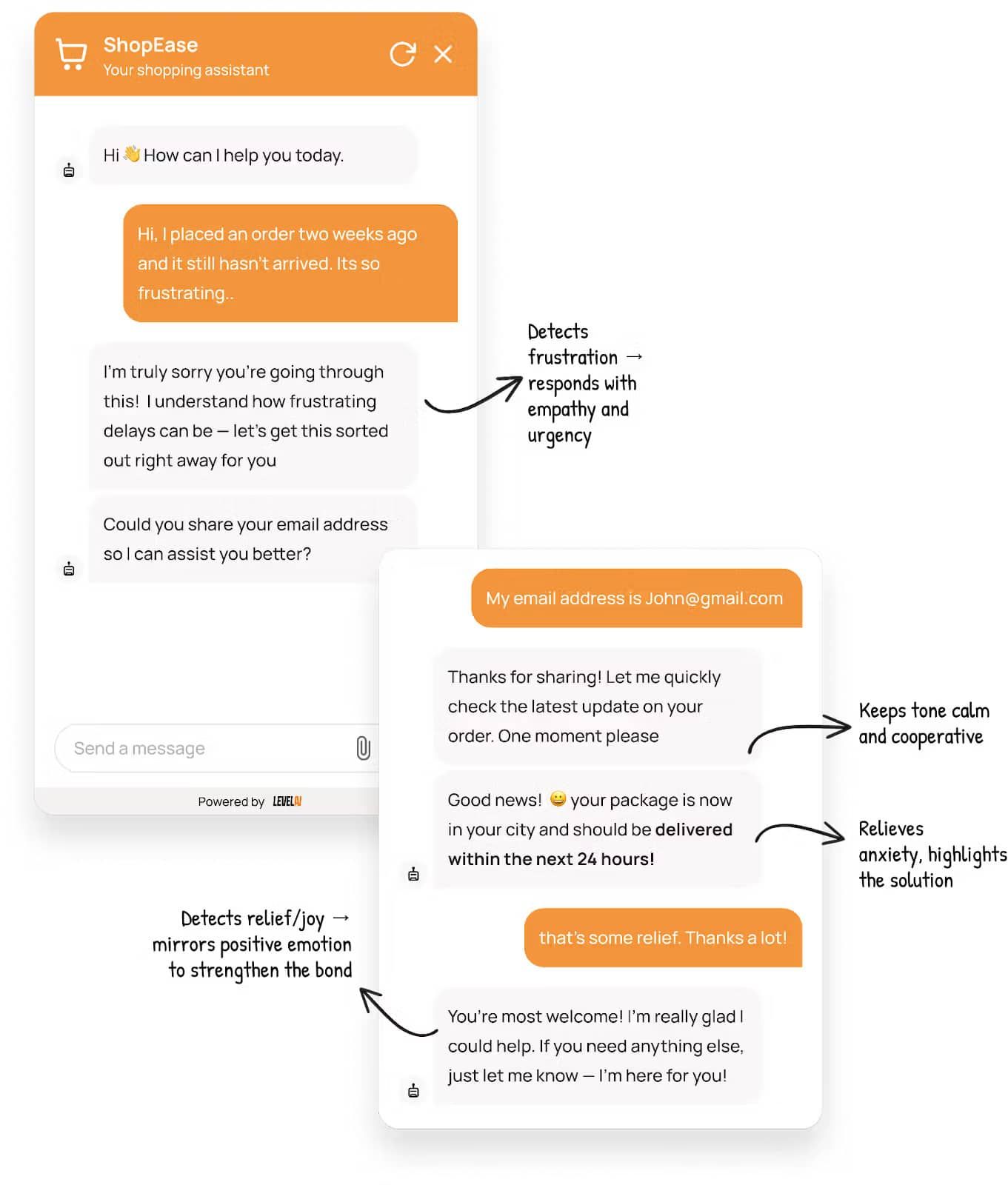
This allows Virtual Agent to decide when a problem is too urgent, emotional, or complex in order to hand it off with all the necessary background included. Unlike traditional chatbots that often leave customers repeating themselves, this approach ensures that the conversation flows from the bot to the human agent.
See our latest article on customer analytics use cases.
4. Autonomous Task Handling for Faster Resolutions
When integrated properly, chatbots can take on real tasks that speed up response times and make the customer experience smoother and more efficient. Instead of just pointing customers to information, advanced bots can perform actions like checking customer records in a CRM, resetting passwords, or offering product recommendations, making customer interactions feel more personal.
To do this, chatbots need strong integrations with business systems, along with guardrails. Our Virtual Agent connects to platforms like Salesforce, Zendesk, and HubSpot, allowing it to directly:
- Modify orders
- Update customer records
- Fetch account details
- Generate customer support tickets
- Trigger refunds
- Send notifications or follow-up communications
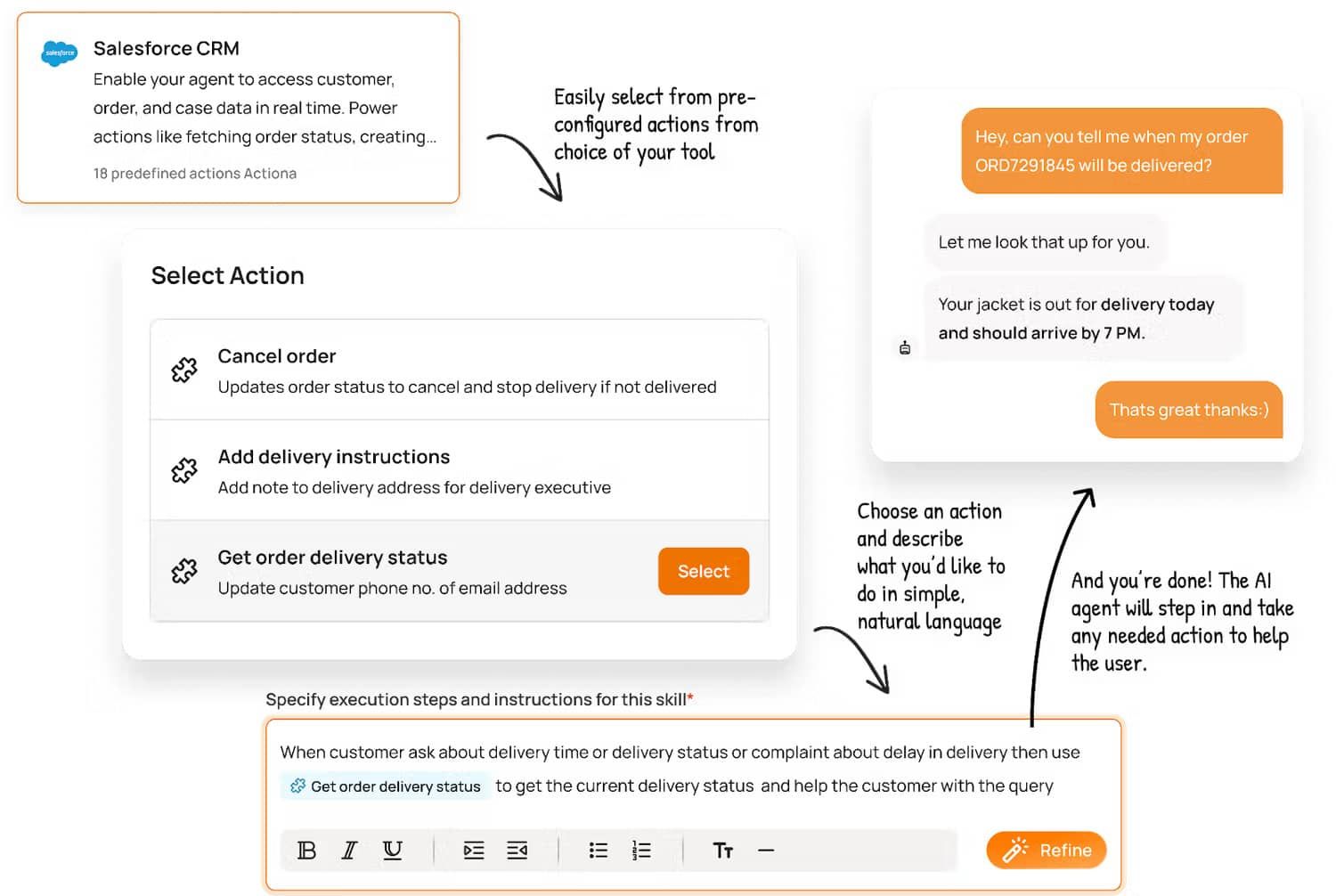
These allow it to solve issues end-to-end without human intervention, giving AI Virtual Agent a 3x better containment rate compared to other bots on the market.
You set up the Virtual Agent by specifying skills, which are discrete tasks that it should handle autonomously. For example, in an e-commerce context, skills might include "Order Status," "Order Modification," or "Order Cancellation."
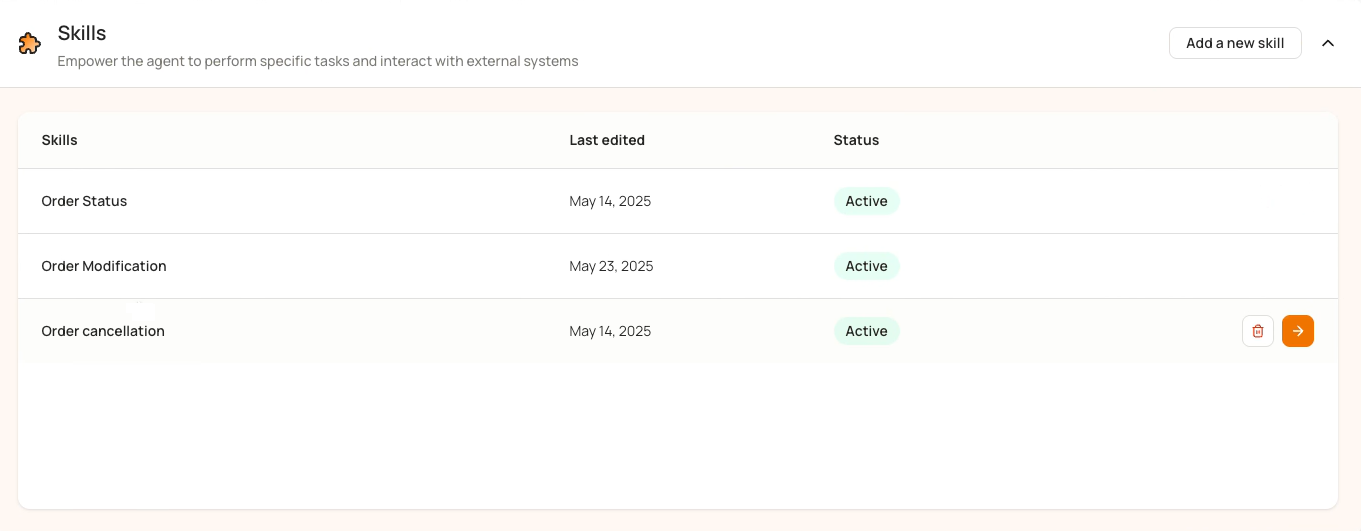
You then define triggers that activate the skill, and give instructions on how the agent should address customers and what kinds of information to ask them.
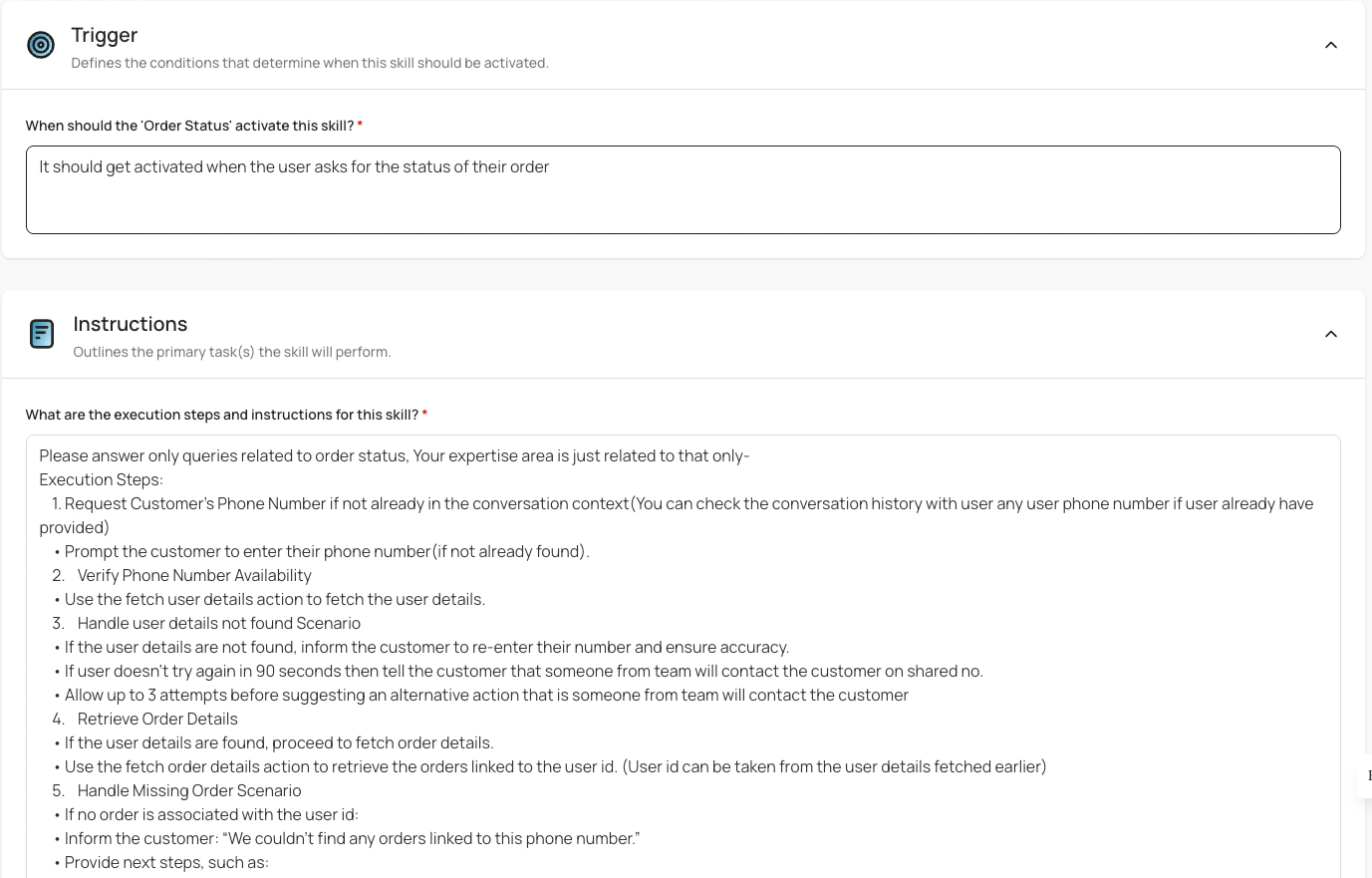
Afterwards, you define actions for the bot to take, like “Modify orders,” and then choose external systems to connect to, like your CRM, ticketing system, knowledge base, etc. These actions are connected to external systems via APIs or pre-built connectors.
Taken together, these elements allow the Virtual Agent to reason through complex situations and not just answer, but plan and execute multi-step tasks within a single interaction. It also ensures the bot pulls from real-time data rather than static or outdated information.
This prevents errors and ensures responses are accurate and grounded in actual business logic. Once configured, the chatbot can be embedded directly into a website or app, with options to customize its look and feel to match a brand’s identity.
The result is a proactive assistant that greets customers, anticipates needs, and completes tasks on their behalf — all while keeping customer interactions efficient, accurate, and aligned with the brand’s voice.
5. Consistent, Human-Like Experiences in Voice and Chat
Deploying chatbots across different channels ensures customers can reach a business through their preferred channel and get a consistent experience, allowing them to pick up conversations exactly where they left off, regardless of channel or device.
Unfortunately, poor integration often gets in the way. When chatbots aren’t fully integrated with a company’s systems, customers can run into fragmented experiences, such as being given conflicting information or having to explain their issue all over again.
Different platforms like Facebook Messenger, WhatsApp, or voice assistants often run on their own systems. This creates silos that make it difficult to share training data, maintain the same tone, or carry context across channels. The result is uneven experiences; for instance, a voice bot might sound overly formal while a chat assistant feels more casual.
Voice is traditionally hard to get right, since legacy bots often sound robotic, rely too heavily on scripts, and struggle to respond with empathy.
The solution is to unify voice and chat on a single intelligence layer. Level AI’s Virtual Agent does exactly that, sharing context, training data, and customer history across every channel. This prevents inconsistencies and makes the bot channel-agnostic, so it can continue conversations naturally, no matter where they started.
Unlike older bots, it’s designed for natural, fluid conversations, not just keyword recognition. By using natural language understanding and conversational AI, it can interpret intent, detect sentiment, and adjust responses based on how the customer is feeling.
If frustration, worry, or excitement is detected, the chatbot adapts its tone and shows empathy, whether in voice or text. It also handles real-life conversation patterns like interruptions, topic changes, and back-and-forth exchanges without breaking the flow.
The result is a more human-like experience across both voice and chat. This consistency and increased customer engagement lead to measurable improvements, such as a 30% higher CSAT and a 50% lower abandonment rate.
To experience a real conversation with an AI Virtual Agent and hear the difference for yourself, feel free to call (716) 588-4326.
6. Turning Every Conversation Into Customer Insights
Chatbots do more than answer questions; they also keep track of how people interact with them. They monitor where users drop off, which questions go unanswered, and when conversations become too long or confusing. Every response a customer gives is analyzed to uncover patterns, and this customer data can include details such as pages visited, shopping carts abandoned, languages used, location, and customer preferences.
Many chatbots also ask for customer feedback directly, usually through a quick survey at the end of a conversation. These surveys can provide useful ratings and comments, but they come with challenges. Most people either skip them or only respond if they had a very positive or very negative experience.
That means businesses often miss the perspectives of the majority of customers who had an average experience. Because of this, surveys don’t always reflect the full picture of customer sentiment.
Advanced chatbots solve this problem by gathering insights directly from interaction data, rather than relying only on surveys. They can detect patterns, measure customer reactions, and surface areas for improvement from 100% of conversations, not just a small sample.
AI Virtual Agent uses a CX closed-loop feedback system, which collects insights from interactions and acts on them. It continuously monitors every conversation to evaluate quality and incorporates call center tracking system software to derive metrics like resolution rates and customer satisfaction. Over time, it learns from these customer interactions, proactively identifying recurring issues and adjusting its responses without requiring human intervention.
This closed-loop feedback system uses several Level AI components:
- Voice of the Customer Insights for surfacing recurring but subtle pain points hidden in conversations, helping Virtual Agent identify automation opportunities not only during setup (which allows it to deploy in days) but also on an ongoing basis.
- iCSAT is an automated score that measures satisfaction based on sentiment, effort, and resolution, providing a full picture of how the customer feels during an interaction. For example, it detects when a customer’s needs are going unmet or where frustration is building up. This helps it understand when and where in a conversation to change its tone or to escalate to a human agent.
- AutoQA, which evaluates (like a human quality reviewer) conversations for things like agent (and artificial intelligence) adherence to company rubrics. This allows Virtual Agent to track various performance-related metrics and to refine its follow-up responses further. It also provides useful data for pre-deployment testing.
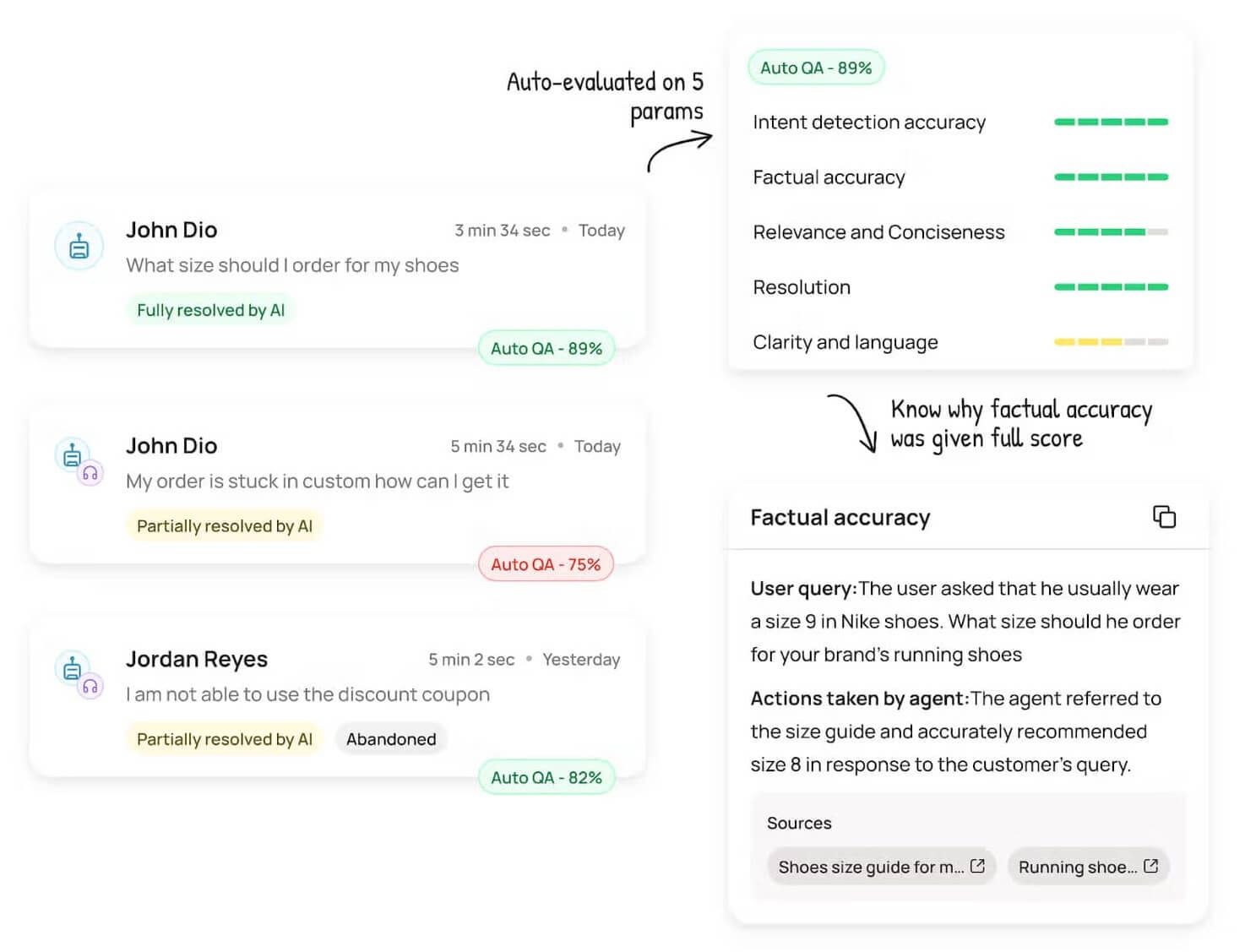
The result is a chatbot experience that gets faster and more empathetic with every human interaction, driving higher service quality, more consistent customer experiences, and actionable improvements to increase call center efficiency over time.
See our latest article on how to improve quality assurance in a contact center.
7. Lower Support Costs Without Sacrificing Quality
Lowering customer support costs is one of the biggest advantages of modern chatbots, and savings over time can be significant. Chatbots can handle simple questions, deflect tickets, and route conversations efficiently, reducing the need for a large support team of human agents.
This matters because human support is becoming increasingly expensive, often costing between $5 and $25 per ticket.
Despite this, chatbots come with their own costs. There’s the upfront cost of setting them up, which can be complex and time-consuming. They also require some maintenance and generally depend on developers to make updates.
Frequent escalations to humans may also be a factor in offsetting potential cost savings, particularly in legacy bots that rely on rigid scripts and keyword matching, and don't understand context well.
For example, a chatbot failing to recognize a billing issue unless the customer uses exact words like “refund” or “return” may slow resolution and increase the chances of escalation.
Advanced AI-driven chatbots can overcome these issues by unifying conversations across channels and delivering consistent, human-like interactions that reduce escalations, speed up response times, and lower overall customer support costs.
For example, Level AI’s Virtual Agent achieves 55% lower setup and maintenance costs compared to other solutions through its ease of setup, which (as already mentioned) doesn't require heavy engineering resources while automating the process of discovering high-frequency and simple customer queries.
Also, its automated quality review and Voice of the Customer software provide a continuous customer feedback loop whose functionality helps the system learn and adapt, improving accuracy, reducing repeated issues, and driving greater efficiency over time.
Overall, AI Virtual Agent’s lower costs in setup and maintenance, human support, higher containment, and unified intelligence layer allow contact centers to cut expenses while still delivering a faster, more consistent, and better customer experience.
Discover What Modern Chatbots Can Do for Your Customers
Deliver faster, more consistent, and more human-like support with an AI chatbot that learns from every human interaction and enables customer self-service. See how Level AI’s Virtual Agent boosts CSAT, reduces escalations, and streamlines your entire customer journey — all while cutting customer support costs.
Schedule a free demo to see how our Virtual Agent delivers scalability, higher containment rates, smoother handoffs, and measurable gains in customer satisfaction. You can also call (716) 588-4326 to chat with our human-like AI agent in real time.
Keep reading
View all





